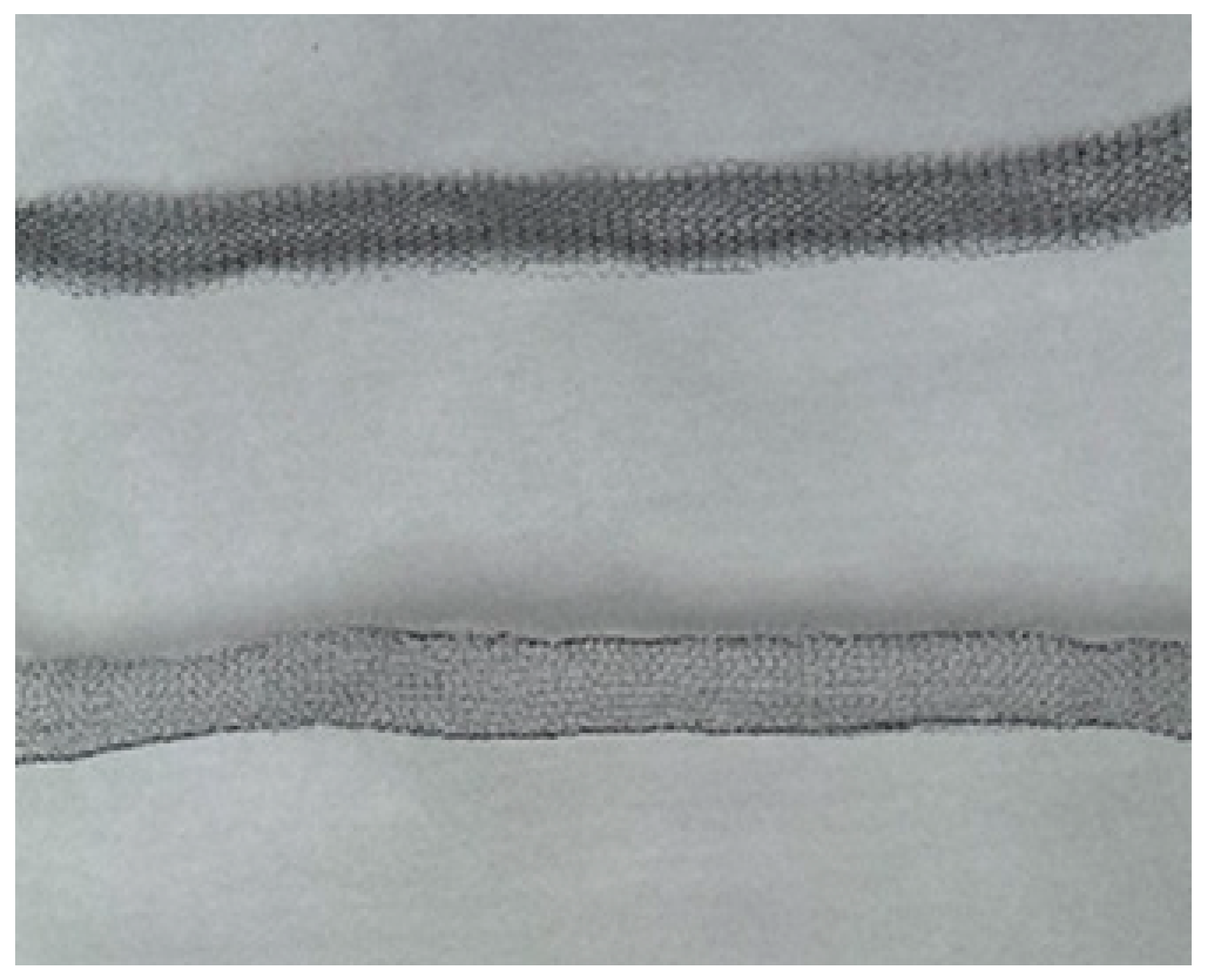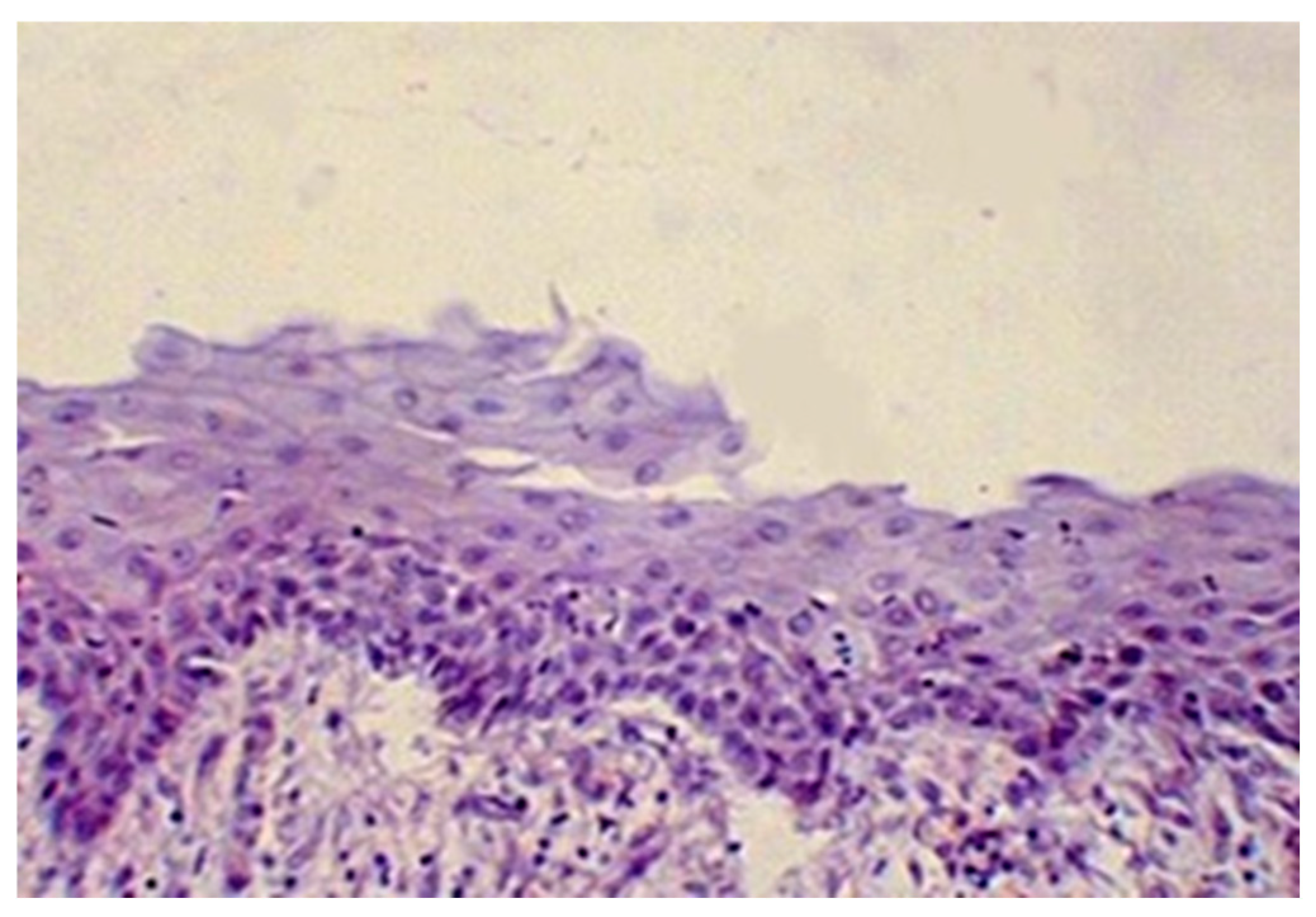Possibilities of Titanium Nickelide Implant Application in Radical Trachelectomy in Patients of Reproductive Age with Invasive Cervical Cancer
Abstract
1. Introduction
2. Materials and Methods
2.1. Patients
- (1)
- CC at T1a2-1bNxM0;
- (2)
- Squamous cell carcinoma;
- (3)
- No cancer spread to the upper third of the cervical canal;
- (4)
- Reproductive age;
- (5)
- Desire to conceive;
- (6)
- Signed informed consent forms.
- (1)
- CC at T3-T4;
- (2)
- Presence of serious comorbidities that made pregnancy and childbirth troubled or impossible;
- (3)
- No desire to conceive;
- (4)
- Refusal to participate in this study.
2.2. Pre-, Intra-, and Postoperative Assessment
2.3. Radical Trachelectomy, Formation of Uterine Closure, and Strengthening of Utero-Vaginal Anastomosis
3. Results
4. Discussion
5. Conclusions
Author Contributions
Funding
Institutional Review Board Statement
Informed Consent Statement
Data Availability Statement
Conflicts of Interest
Abbreviations
| CC | cervical cancer |
References
- Bray, F.; Laversanne, M.; Sung, H.; Ferlay, J.; Siegel, R.L.; Soerjomataram, I.; Jemal, A. Global cancer statistics 2022: GLOBOCAN estimates of incidence and mortality worldwide for 36 cancers in 185 countries. CA Cancer J. Clin. 2024, 74, 229–263. [Google Scholar] [CrossRef] [PubMed]
- Zaveri, V.; Aghajafari, F.; Amankwah, K. Abdominal versus vaginal cerclage after a failed transvaginal cerclage: A sistematic review. Am. J. Obstet. Gynecol. 2002, 187, 868–872. [Google Scholar] [CrossRef] [PubMed]
- Huang, X.; Ma, N.; Li, T.C.; Guo, Y.; Song, D.; Zhao, Y.; Xia, E. Simplified laparoscopic cervical cerclage after failure of vaginal suture: Technique and results of a consecutive series of 100 cases. Eur. J. Obstet. Gynecol. Reprod. Biol. 2016, 201, 146–150. [Google Scholar] [CrossRef] [PubMed]
- Chernyshova, A.; Kolomiets, L.; Chekalkin, T.; Chernov, V.; Sinilkin, I.; Gunther, V.; Marchenko, E.; Baigonakova, G.; Kang, J.H. Fertility-Sparing Surgery Using Knitted TiNi Mesh Implants and Sentinel Lymph Nodes: A 10-Year Experience. J. Investig. Surg. 2021, 34, 1110–1118. [Google Scholar] [CrossRef] [PubMed]
- Kaprin, A.; Ashrafyan, L.; Stilidi, I. Gynecologic Oncology: A National Guideline; GEOTAR Media: Moscow, Russia, 2019; ISBN 978-5-9704-5329-2. [Google Scholar]
- Okugawa, K.; Kobayashi, H.; Sonoda, K.; Kaneki, E.; Kawano, Y.; Hidaka, N.; Egashira, K.; Fujita, Y.; Yahata, H.; Kato, K. Oncologic and obstetric outcomes and complications during pregnancy after fertility-sparing abdominal trachelectomy for cervical cancer: A retrospective review. Int. J. Clin. Oncol. 2017, 22, 340–346. [Google Scholar] [CrossRef] [PubMed]
- Salvo, G.; Pareja, R.; Ramirez, P.T. Minimally invasive radical trachelectomy: Considerations on surgical approach. Best Pr. Res. Clin. Obstet. Gynaecol. 2021, 75, 113–122. [Google Scholar] [CrossRef] [PubMed]
- Smith, J.R.; Boyle, D.C.; Corless, D.J.; Ungar, L.; Lawson, A.D.; Del Priore, G.; McCall, J.M.; Lindsay, I.; Bridges, J.E. Abdominal radical trachelectomy: A new surgical technique for the conservative management of cervical carcinoma. Br. J. Obstet. Gynaecol. 1997, 104, 1196–1200. [Google Scholar] [CrossRef] [PubMed]
- Nezhat, C.; Roman, R.A.; Rambhatla, A.; Nezhat, F. Reproductive and oncologic outcomes after fertility-sparing surgery for early stage cervical cancer: A systematic review. Fertil. Steril. 2020, 113, 685–703. [Google Scholar] [CrossRef] [PubMed]
- Salvo, G.; Ramirez, P.T.; Leitao, M.; Cibula, D.; Fotopoulou, C.; Kucukmetin, A.; Rendon, G.; Perrotta, M.; Ribeiro, R.; Vieira, M.; et al. International radical trachelectomy assessment: IRTA study. Int. J. Gynecol. Cancer 2019, 29, 635–638. [Google Scholar] [CrossRef] [PubMed]
- Nitecki, R.; Woodard, T.; Rauh-Hain, J.A. Fertility-Sparing Treatment for Early-Stage Cervical, Ovarian, and Endometrial Malignancies. Obstet. Gynecol. 2020, 136, 1157–1169. [Google Scholar] [CrossRef] [PubMed]
- Chernyshova, A.; Kolomiets, L.; Gyunter, V. New surgical aspects of organ-preserving treatment in patients with invasive cervical cancer after radical trachelectomy. Probl. Oncol. 2017, 63, 743–747. (In Russian) [Google Scholar] [CrossRef]
- Nemejcova, K.; Kocian, R.; Kohler, C.; Jarkovsky, J.; Klat, J.; Berjon, A.; Pilka, R.; Sehnal, B.; Gil-Ibanez, B.; Lupo, E.; et al. Central Pathology Review in SENTIX, A Prospective Observational International Study on Sentinel Lymph Node Biopsy in Patients with Early-Stage Cervical Cancer (ENGOT-CX2). Cancers 2020, 12, 1115. [Google Scholar] [CrossRef] [PubMed]
- Chernyshova, A.L.; Kolomiets, L.A.; Trushchuk, Y.M.; Shpileva, O.V.; Denisov, E.V.; Larionova, I.V.; Startseva, Z.h.A.; Chernov, V.I.; Marchenko, E.S.; Chekalkin, T.L.; et al. Modern approaches to the choice of treatment tactics in patients with cervical cancer. Tumors Female Reprod. Syst. 2021, 17, 128–133. (In Russian) [Google Scholar] [CrossRef]
- Choi, Y.J.; Moskowitz, J.M.; Myung, S.K.; Lee, Y.R.; Hong, Y.C. Cellular Phone Use and Risk of Tumors: Systematic Review and Meta-Analysis. Int. J. Environ. Res. Public Health 2020, 17, 8079. [Google Scholar] [CrossRef] [PubMed]
- McCormack, M.; Gaffney, D.; Tan, D.; Bennet, K.; Chavez-Blanco, A.; Plante, M. The Cervical Cancer Research Network (Gynecologic Cancer InterGroup) roadmap to expand research in low- and middle-income countries. Int. J. Gynecol. Cancer 2021, 31, 775–778. [Google Scholar] [CrossRef] [PubMed]
- Small, W., Jr.; Peltecu, G.; Puiu, A.; Corha, A.; Cocîrṭă, E.; Cigăran, R.G.; Plante, M.; Jhingran, A.; Stang, K.; Gaffney, D.; et al. Cervical cancer in Eastern Europe: Review and proceedings from the Cervical Cancer Research Conference. Int. J. Gynecol. Cancer 2021, 31, 1061–1067. [Google Scholar] [CrossRef] [PubMed]
- Abu-Rustum, N.R.; Yashar, C.M.; Bean, S.; Bradley, K.; Campos, S.M.; Chon, H.S.; Chu, C.; Cohn, D.; Crispens, M.A.; Damast, S.; et al. NCCN Guidelines Insights: Cervical Cancer, Version 1.2020. J. Natl. Compr. Canc. Netw. 2020, 18, 660–666. [Google Scholar] [CrossRef] [PubMed]
- Arbyn, M.; Weiderpass, E.; Bruni, L.; de Sanjosé, S.; Saraiya, M.; Ferlay, J.; Bray, F. Estimates of incidence and mortality of cervical cancer in 2018: A worldwide analysis. Lancet Glob. Health 2020, 8, e191–e203. [Google Scholar] [CrossRef] [PubMed]
- Popov, A.A.; Fedorov, A.A.; Vrotskaya, V.S.; Antipov, V.A.; Tumanova, V.A.; Kapustina, M.V.; Krasnopolskaya, K.V.; Chechneva, M.A.; Lysenko, S.N. Preconception preparation (cerclage) after radical cervical surgery. P.A. Herzen J. Oncol. 2015, 4, 39–42. (In Russian) [Google Scholar] [CrossRef]



| Variables | n | % |
|---|---|---|
| Conception mode | 60/118 | 50.8 |
| Spontaneous | 42/60 | 70.0 |
| Assisted reproductive technology | 18/60 | 30.0 |
| Pregnancies | ||
| Currently pregnant | 18/60 | 30.0 |
| Successful childbirth, 29 > x > 40 weeks | 29/60 | 48.3 |
| Early abortion, <10 weeks | 11/60 | 18.3 |
| Miscarriage, <24 weeks | 2/60 | 3.3 |
| Cervical stenosis | 0/118 | 0 |
Disclaimer/Publisher’s Note: The statements, opinions and data contained in all publications are solely those of the individual author(s) and contributor(s) and not of MDPI and/or the editor(s). MDPI and/or the editor(s) disclaim responsibility for any injury to people or property resulting from any ideas, methods, instructions or products referred to in the content. |
© 2025 by the authors. Licensee MDPI, Basel, Switzerland. This article is an open access article distributed under the terms and conditions of the Creative Commons Attribution (CC BY) license (https://creativecommons.org/licenses/by/4.0/).
Share and Cite
Chernyshova, A.; Krylyshkin, M.; Chernyakov, A.; Truschuk, J.; Marchenko, E.S.; Fursov, S.; Tkachuk, O.; Tamkovich, S. Possibilities of Titanium Nickelide Implant Application in Radical Trachelectomy in Patients of Reproductive Age with Invasive Cervical Cancer. Reprod. Med. 2025, 6, 24. https://doi.org/10.3390/reprodmed6030024
Chernyshova A, Krylyshkin M, Chernyakov A, Truschuk J, Marchenko ES, Fursov S, Tkachuk O, Tamkovich S. Possibilities of Titanium Nickelide Implant Application in Radical Trachelectomy in Patients of Reproductive Age with Invasive Cervical Cancer. Reproductive Medicine. 2025; 6(3):24. https://doi.org/10.3390/reprodmed6030024
Chicago/Turabian StyleChernyshova, Alyona, Michael Krylyshkin, Alexander Chernyakov, Julia Truschuk, Ekaterina S. Marchenko, Sergey Fursov, Olga Tkachuk, and Svetlana Tamkovich. 2025. "Possibilities of Titanium Nickelide Implant Application in Radical Trachelectomy in Patients of Reproductive Age with Invasive Cervical Cancer" Reproductive Medicine 6, no. 3: 24. https://doi.org/10.3390/reprodmed6030024
APA StyleChernyshova, A., Krylyshkin, M., Chernyakov, A., Truschuk, J., Marchenko, E. S., Fursov, S., Tkachuk, O., & Tamkovich, S. (2025). Possibilities of Titanium Nickelide Implant Application in Radical Trachelectomy in Patients of Reproductive Age with Invasive Cervical Cancer. Reproductive Medicine, 6(3), 24. https://doi.org/10.3390/reprodmed6030024







